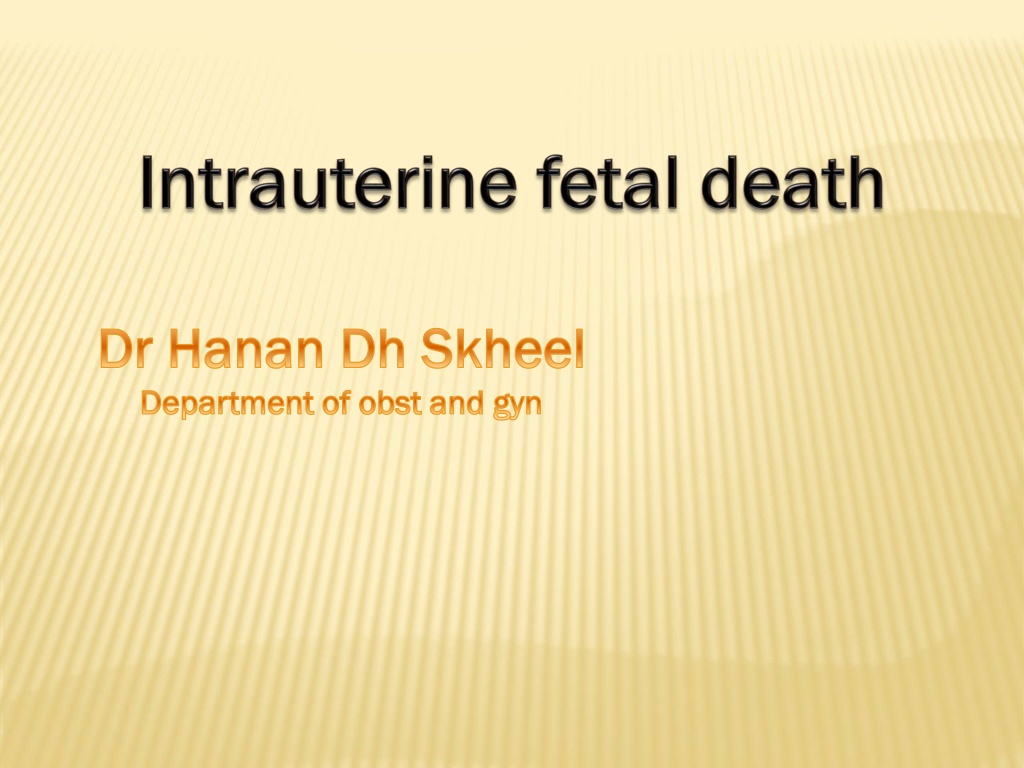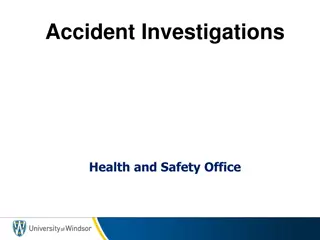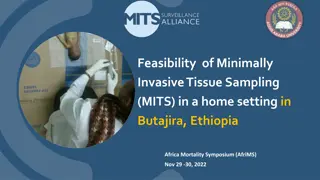Understanding Stillbirth: Causes, Symptoms, and Investigations
Stillbirth, the delivery of a baby with no signs of life after 20 completed weeks of pregnancy, can have profound emotional and social effects. Unexplained causes account for 50% of cases, with fetal, placental, and maternal factors contributing. Risk factors include obesity, maternal age, smoking, infections, medical conditions, and trauma. Placental causes like abruption and fetal causes like IUGR play a role. Symptoms include absence of fetal movements, and investigations like ultrasound help in diagnosis.
Download Presentation

Please find below an Image/Link to download the presentation.
The content on the website is provided AS IS for your information and personal use only. It may not be sold, licensed, or shared on other websites without obtaining consent from the author. Download presentation by click this link. If you encounter any issues during the download, it is possible that the publisher has removed the file from their server.
E N D
Presentation Transcript
Dr Dr Hanan Hanan Dh Department of obst and gyn Department of obst and gyn Dh Skheel Skheel
stillbirth a baby delivered with no signs of life known to have died after 20 completed weeks of pregnancy . Intrauterine fetal death Refers to babies with no signs of life in utero. Incidence 1 in 200 In addition to any physical effects, stillbirth often has profound emotional, psychiatric and social effects on parents, their relatives and friends
Unexplained Unexplained 50 50% % Fetal causes 25-40% Placental causes 20-35% Maternal 5-10%
) Obesity (>30kg/m2): proven, modifiable, highest ranking Maternal (>35yrs)/paternal age Smoking/Alcohol/Drug abuse Infections (malaria, hepatitis, influenza, syphilis, Toxoplasma, sepsis) Medical ds DM,HT,Thyroid Diseases Pre-existing diseases (HD, Anemia, Epilepsy) Autoimmune Disorders (APS, SLE) RH incompatibility Hyperpyrexia Thrombophilias Trauma Cholestasis of pregnancy Obs cx Abruption,PPROM,multifetal gestation Labour related (preterm, dystocia, uterine rupture)
PLACENTAL CAUSES PLACENTAL CAUSES . Abruption Cord accidents Placental insufficiency Placenta previa TTTS Chorioamnionitis PROM Feto-maternal hemorrhage Iatrogenic- ECV, Drug overdoses
FOETAL CAUSES FOETAL CAUSES Multiple gestation IUGR Congenital anomalies Infections Hydrops (immune & non-immune) G6PD deficiency
Symptoms: Absence of fetal movements Signs: Regression of the positive breast changes Per abdomen Gradual regression of the height of the uterus Uterine tone is diminished Fetal movement are not felt during palpation Fetal heart sound is not audible INVESTIGATIONS USG (100%) Associated features can be noted (oligo, hydrops) Robert s sign : Appearance of gas shadow (in 12 hours) Spalding sign: Collapse skull bones (usually appears 7 days) Ball sign : Hyperflexion of the spine Helix sign : Gas in umbilical arteries Crowding of the ribs shadow
Auscultation and cardiotocography should not be used to investigate suspected IUFD. Real-time ultrasonography is essential for the accurate diagnosis of IUFD. Ideally, real-time ultrasonography should be available at all times. A second opinion should be obtained whenever practically possible. Mothers should be prepared for the possibility of passive fetal movement. If the mother reports passive fetal movement after the scan to diagnose IUFD, a repeat scan should be offered. Auscultation of the fetal heart by Pinard stethoscope or Doppler ultrasound is insufficiently accurate for diagnosis
Breaking bad news Breaking bad news If the woman is unaccompanied, an immediate offer should If the woman is unaccompanied, an immediate offer should be made to call her partner, relatives or be made to call her partner, relatives or friends. friends. Discussions should aim to support maternal/parental Discussions should aim to support maternal/parental choice. choice. Parents should be offered written information to Parents should be offered written information to supplement discussions supplement discussions
Clinical assessment and laboratory tests should be Clinical assessment and laboratory tests should be recommended recommended To assess maternal wellbeing To assess maternal wellbeing (including coagulopathy) (including coagulopathy) To determine the cause of death, To determine the cause of death, the chance of recurrence the chance of recurrence Possible means of avoiding further Possible means of avoiding further pregnancy complications pregnancy complications Parents should be advised that no specific cause is found in almost Parents should be advised that no specific cause is found in almost half half of stillbirths. of stillbirths. Parents should be advised that when a cause is found it can crucially Parents should be advised that when a cause is found it can crucially influence care in a future pregnancy influence care in a future pregnancy
Another important purpose of investigation is to assess maternal wellbeing and ensure prompt management of any potentially life-threatening maternal disease. This includes a detailed history of events during pregnancy and clinical examination for pre eclampsia eclampsia, chorioamnionitis and placental abruption , chorioamnionitis and placental abruption. There is also a moderate risk of maternal disseminated intravascular coagulation (DIC): 10% within 4 weeks after the date of late IUFD, rising to 30% thereafter. This can be tested for by clotting studies, blood platelet count and fibrinogen measurement. Obvious cause - No further testing or limited testing (cord accidents, anencephaly) pre- -
Recurrent abortions Congenital anomalies Abnormal karyotype Hereditary conditions Developmental dela Maternal Maternal DM HPT Thrombophilias Autoimmune disease Severe Anemia Epilepsy Consanguinity Heart disease Past Obstetrical Baby with congenital anomaly / hereditary condition IUGR Gestational HPT with adverse sequele Placental abruption IUFD Recurrent abortions Past Obstetrical Past Obstetrical Baby with congenital anomaly / hereditary condition IUGR Gestational HPT with adverse sequele Placental abruption IUFD Recurrent abortions Past Obstetrical
Gross description Gross description Infant description Infant description Malformation Skin staining Degree of maceration Color-pale , plethoric Umbilical cord Umbilical cord Prolapse Entanglement-neck, arms, legs Hematoma or stricture Number of vessels Length Amniotic fluid Amniotic fluid Color-meconium, blood Volume Placenta Weight Staining Adherent clots Structural abnormality Velamentous insertion Edema/ hydropic changes Membranes Thickening Fetal Autopsy & Fetal Autopsy & Karyotyping Karyotyping These 2 are important tests in SB evaluation Crucial for future pregnancy Appropriate consent req to take fetal tissue,Autopsy Ideally should be done by perinatal pathologist If denied, post mortem MRI should be considered Radiographs if indicated for skeletal abnormalities Photographs Membranes Stained
Fetal karyotyping (recomeded in all cases) esp- - Dysmorphic fetus, FGR - Hydropic - Signs of chromosomal anomaly Samples- Parents with multiple pregnancy losses (second or third trimester) For aneuploidy- FISH, For small deletions- Amniocentesis highest yield 3ml fetal blood from umbilical vs and or cardiac puncture-heparinized bulb If blood not obtained at least 1 of the follwing samples - 1) Placental block 1x1cm 2) cord 1.5cm 3) costocondral junction or patellar (skin not . recommended)
Chorionicity Cord knot, vessels, thrombosis Infarcts, thrombosis, abruption Vascular malformations Signs of infection Placental block(1x1 cm) below cord insertion Umbilical segment (1.5 cm) Placental swabs for infections Bacterial cultures for E. Coli, Listeria .
CBC Hb electrophoresis Diabetes testing (HbA1c, FBS) Additional Tests Kleihauer (for all women, beforebirth), in Rh- D negative second test after antidote Serological Tests (TORCH, Syphilis, Parvovirus) ?? in all cases, opinion varies, rarely helpful If clinical findings suggest intrauterine infection (i.e., those with IUGR, microcephaly) Antiphospholipid (LA,ACA), Antiplatelet Ab if ICH detected ?? Thrombophilias screening (6 weeks postpartum) - factor V leiden mutations & deficiencies, antithombin III, protein C & S Current Bile acids (Cholestasis of preg)- important cause, recurrence in 80% cases High vaginal & cervical swab for C & S Urine toxicology screening (cocaine, amphetamines ,associated with abruption)
Depends on: Depends on: Single or multiple gestation Single or multiple gestation Gestation age at death Gestation age at death Parents wish (varied response) Parents wish (varied response) Expectant approach More than 85% of women with an IUFD labour spontaneously within three weeks of diagnosis. If the woman is physically well, her membranes are intact and there is no evidence of pre-eclampsia, infection or bleeding, the risk of expectant management for 48 hours is low. There is a 10% chance of maternal DIC within 4 weeks from the date of fetal death and an increasing chance thereafter, emotional burden, and risk of Chorioamnionitis Chorioamnionitis Active approach Fetal death < Fetal death <28 28weeks weeks Mifepristone Mifepristone 200 200 mg followed by mg followed by Misoprostol Misoprostol 400 with shortest I with shortest I- -D interval D interval Fetal death > Fetal death >28 28weeks weeks Cervical ripening (mechanical or chemical) followed by Cervical ripening (mechanical or chemical) followed by Oxytocin Oxytocin induction induction Induction Induction of Labour of Labour emotional burden, and risk of 400 g g 4 4 - - 6 6 hourly most effective hourly most effective
Vaginal birth can be achieved within 24 hours of induction of labour for IUFD in about 90% of women . Vaginal birth carries the potential advantages of immediate recovery and quicker return to home . Caesarean birth might occasionally be clinically indicated by virtue of maternal condition. The woman herself might request caesarean section because of previous experiences or a wish to avoid vaginal birth of a dead baby.Vaginal birth was described as emotionally distressing
WHO regimen of Misoprostol in IUD cases IUFD at term 25 g 6 hourly 2doses, if no response increase to 50 g 6 hourly, do not exceed 4 doses. Do not use Oxytocin in 8hrs of using Misoprostol Contraindicated in previous CS cases (WHO) RCOG & NICE Regimen <26 weeks - 100 g 6hrly (max 4 doses) >27 weeks - 25-50 g 4hrly (max 6 doses) Use of PGs is associated with increase risk of uterine rupture in cases of previous scar Membranes should not be ruptured as long as possible Pain management should be offered Keep watch on CBC, coagulation profile, signs of infection Active management of III stage of labour Keep blood and blood products ready
Diamorphine should be used in preference to pethidine. Regional anaesthesia should be available for women with an IUFD. Assessment for DIC and sepsis should be undertaken before administering regional anaesthesia. Women should be offered an opportunity to meet with an obstetric anaesthetist.
Complications Infection PPH Retained placenta Abruption DIC Shock, renal failure Sepsis Maternal death Emotional support & Counseling as they r at increased risk of (PPD) Keep in non maternity ward Suppression of lactation (tight breast support, dopamine agonists,) Counsel for future pregnancy, early ANC visit, preconceptional testing Assurance in cases of non recurring causes Contraceptive counseling
Preconception or initial prenatal visit Detailed medical and obstetric history Evaluation and workup of previous stillbirth Determination of recurrence risk Smoking cessation Weight loss in obese women ( Genetic counselling if family genetic condition exists Medical problem like Diabetes should be managed prior to [pregnancy Thrombophilia workup: antiphospholipid antibodies (only if specifically indicated) Risk of recurrence is 7-10 / 1000 birth Support and reassurance
First trimester First trimester Dating sonography First-tri screen: pregnancy- associated plasma protein A, b HCG, and nuchal translucency* Folic acid Second trimester Fetal ultrasonographic anatomic survey at 18 20wks Maternal serum screening (Quadruple) marker Blood investigations Third trimester Sonographic screening for fetal growth restriction after 28 weeks of gestation Admission at critical period in high risk cases Kick counts starting at 28 weeks of gestation Antipartum fetal surveillance starting at 32 wks or 1 2 wks earlier than prior stillbirth Weekly FHR , BPP, Doppler Support and reassurance
No sure method to prevent Loosing weight, life style modifications Women should try to optimize their health prior to pregnancy Enough Folic acid before they get pregnant Good preconception and prenatal care Women with DM tight control before and during pregnancy Educate women not to delay pregnancy
special recommendations for women with an IUFD who are rhesus D-negative Women who are rhesus D (RhD)-negative should be advised to have a Kleihauer test undertaken urgently to detect large feto maternal haemorrhage (FMH) that might have occurred a few days earlier. Anti-RhD gammaglobulin should be administered as soon as possible after presentation. If there has been a large FMH, the dose of anti-RhD gammaglobulin should be adjusted upwards and the Kleihauer test should be repeated at 48 hours to ensure the fetal red cells have cleared. If it is important to know the baby s blood group; if no blood sample can be obtained from the baby or cord, RhD typing should be undertaken using free fetal DNA (ffDNA) from maternal blood taken shortly after birth.
Major FMH is a silent cause of IUFD and a Kleihauer test is recommended for all women to diagnose the cause of death . In those women who are RhD-negative, the potentially sensitising bleed might have occurred days before the death is recognised,threatening the window for optimal timing of anti-RhD gammaglobulin administration gammaglobulin provides reduced benefit when given beyond 72 hours, up to 10 days after the sensitising event. (72 hours). Anti-RhD























